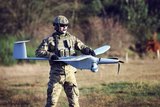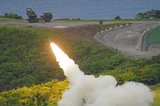Costs of composites affect Indian defence production
A total of 2,240kg of composites goes into the Tejas fighter, but the price of these materials has risen steeply. (Photo: Gordon Arthur)
Production delays in indigenous defence equipment that uses composites are expected to continue, as India struggles with challenges associated with rising import bills and disruption to supply chains of specialised military materials during the COVID-19 pandemic.
The Light Combat Aircraft (LCA) Mk1A, which uses carbon composites in 45% of its airframe, is the first victim. The first batch is to be delivered by February 2024.
Some of the 463 vendors in the LCA programme – supplying carbon wing skins, forward fuselage, flaperons, rudder, keel beam, front fairing, upper fuselage shells, crown and side panels – are already struggling with ‘raw material
Already have an account? Log in
Want to keep reading this article?
More from Defence Notes
-
![Taiwan approved for purchase of $11 billion in weapons from US]()
Taiwan approved for purchase of $11 billion in weapons from US
The US State Department’s approval of a multi-billion-dollar sale of weapons to Taiwan includes tactical mission networks equipment, uncrewed aerial systems, artillery rocket systems and self-propelled howitzers as well as anti-tank guided missiles.
-
![Ireland spells out $2.3 billion shopping list in five-year defence spending plan]()
Ireland spells out $2.3 billion shopping list in five-year defence spending plan
Ireland’s multi-annual investment in capital defence spending is set to rise from €300m in 2026 to €360m in 2029–2030 with major upgrades across land, air, maritime and cyber domains.
-
![US National Security Strategy prioritises advanced military capabilities and national industry]()
US National Security Strategy prioritises advanced military capabilities and national industry
The 2025 NSS has emphasised investment in the US nuclear and air defence inventory and national industry, but it leaves multiple unanswered questions on how the White House will implement this approach.
-
![Canada set to look away from its neighbour and across the Atlantic for partners]()
Canada set to look away from its neighbour and across the Atlantic for partners
While non-EU UK struggles to join the Security Action for Europe initiative, which provides loans for defence programmes, Canada has become the first country outside Europe to get access – and did so for a nominal fee.
-
![NATO experiments with solutions to integrate networks, AI and uncrewed systems]()
NATO experiments with solutions to integrate networks, AI and uncrewed systems
During the latest edition of the NATO DiBaX, the alliance tested multiple capabilities to inform requirements for future efforts.

























